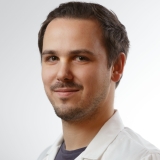
Center for Medical Physics and Biomedical Engineering
Position: Research Associate (Postdoc)
ORCID: 0000-0003-3471-0986
T +43 1 0043 40400 17150
richard.haindl@meduniwien.ac.at
Keywords
Allergy and Immunology; Angiography; Animal models; Bacterial Infections; Biofilms; Biomedical Engineering; Biomedical Research; Host-Pathogen Interactions; Machine Learning; Multimodal Imaging; Mycobacterium tuberculosis; Optical Imaging; Organoids; Photoacoustic Techniques
Research group(s)
- Leitgeb & Drexler Group
Research Area: Advancing biomedical optical imaging for a step change in medical diagnostics as well as in fundamental biological and medical research by developing cutting edge optical technologies combining strengths of different imaging modalities.
Members:
Research interests
I am a Principal Investigator at the Medical University of Vienna, Center for Medical Physics and Biomedical Engineering. My current research focuses on multimodal preclinical imaging and the development of novel optical coherence photoacoustic microscopy systems. Additionally, I am working on specialized imaging techniques to address critical needs in microbiology, particularly in the areas of biofilms and host-pathogen interactions.
With the support of the Horizon Europe programme, I am expanding my research to include infectiology and immunology. Through the use of OCT, we are able to gain detailed insights into the pathogenesis of viruses and the host immune response. This technology allows for the real-time, non-invasive visualization of structural and functional changes in tissues or three-dimensional cell cultures. In the case of organoids, OCT helps visualize virus-host interactions and immune responses, facilitating the development of new therapeutic strategies and fostering research collaborations. My goal is to improve the diagnosis and treatment of infectious diseases and contribute significantly to public health.
My main scientific interests lie in multifunctional and molecular optical imaging, photoacoustics, OCT-angiography, Doppler and polarization-sensitive OCT, machine/deep learning, and in/ex-vivo clinical and preclinical studies.
Techniques, methods & infrastructure
- Photoacoustic microscopy (PAM) at various wavelengths
- Optical coherence microscopy (OCM)
- Doppler optical coherence microscopy (D-OCM)
- Machine learning
- Deep Learning
- Model organisms: organoids, biofilm, zebrafish larvae, chick embryos
Grants
- VIRAL - Viral Infectiology Research with Advanced Laboratory models (2023)
Source of Funding: Medical University of Vienna, Horizon Europe research and innovation programme under grant agreement No 101046133 (ISIDORe)
Principal Investigator
Selected publications
- Wolfgang, M. et al. (2023) ‘Ultra-high-resolution optical coherence tomography for the investigation of thin multilayered pharmaceutical coatings’, International Journal of Pharmaceutics, 643, p. 123096. Available at: https://doi.org/10.1016/j.ijpharm.2023.123096.
- Haindl, R. et al. (2023) ‘Visible light photoacoustic ophthalmoscopy and near-infrared-II optical coherence tomography in the mouse eye’, APL Photonics, 8(10). Available at: https://doi.org/10.1063/5.0168091.
- Deloria, A.J. et al. (2021) ‘Ultra-High-Resolution 3D Optical Coherence Tomography Reveals Inner Structures of Human Placenta-Derived Trophoblast Organoids’, IEEE Transactions on Biomedical Engineering, 68(8), pp. 2368–2376. Available at: https://doi.org/10.1109/tbme.2020.3038466.
- Haindl, R. et al. (2020) ‘Functional optical coherence tomography and photoacoustic microscopy imaging for zebrafish larvae’, Biomedical Optics Express, 11(4), p. 2137. Available at: https://doi.org/10.1364/boe.390410.
- Wang, Z. et al. (2020) ‘NIR nanoprobe-facilitated cross-referencing manifestation of local disease biology for dynamic therapeutic response assessment’, Chemical Science, 11(3), pp. 803–811. Available at: https://doi.org/10.1039/c9sc04909f.